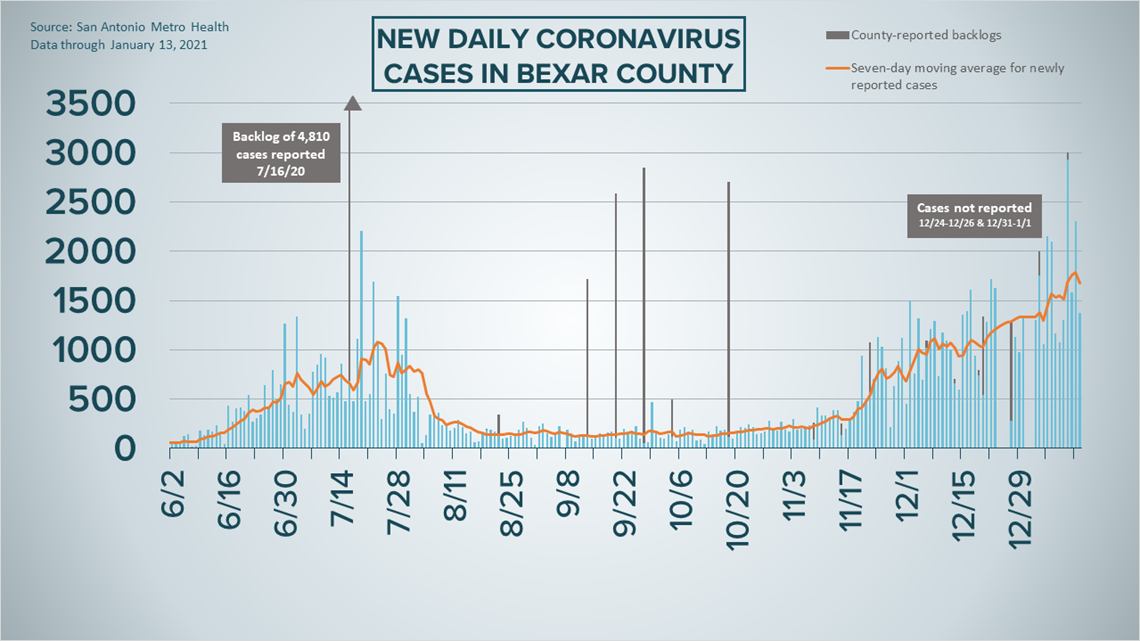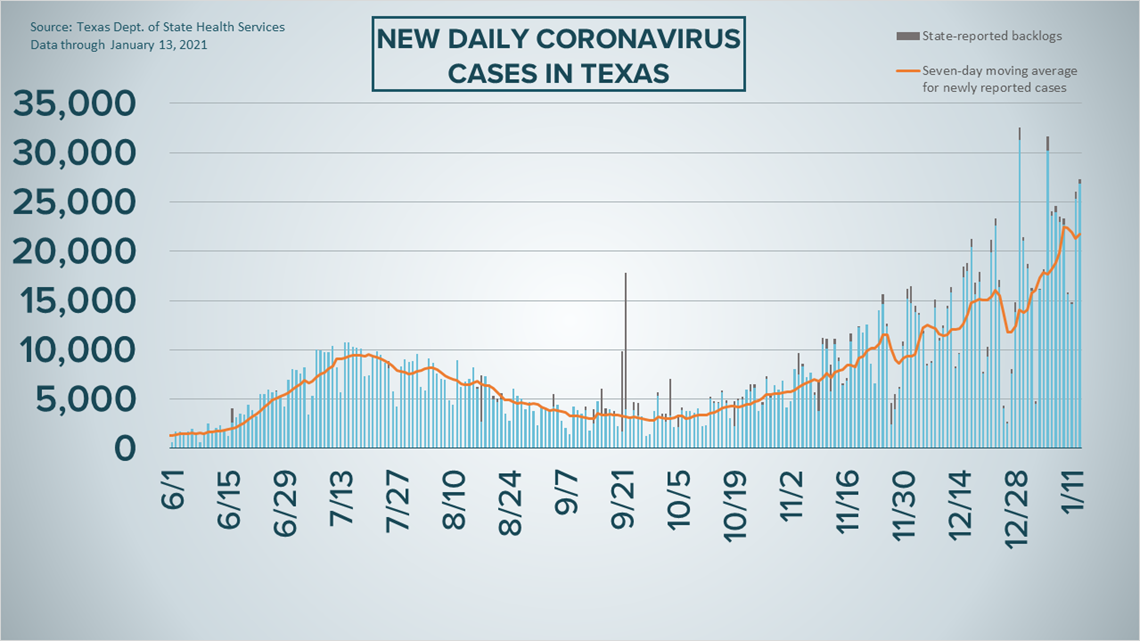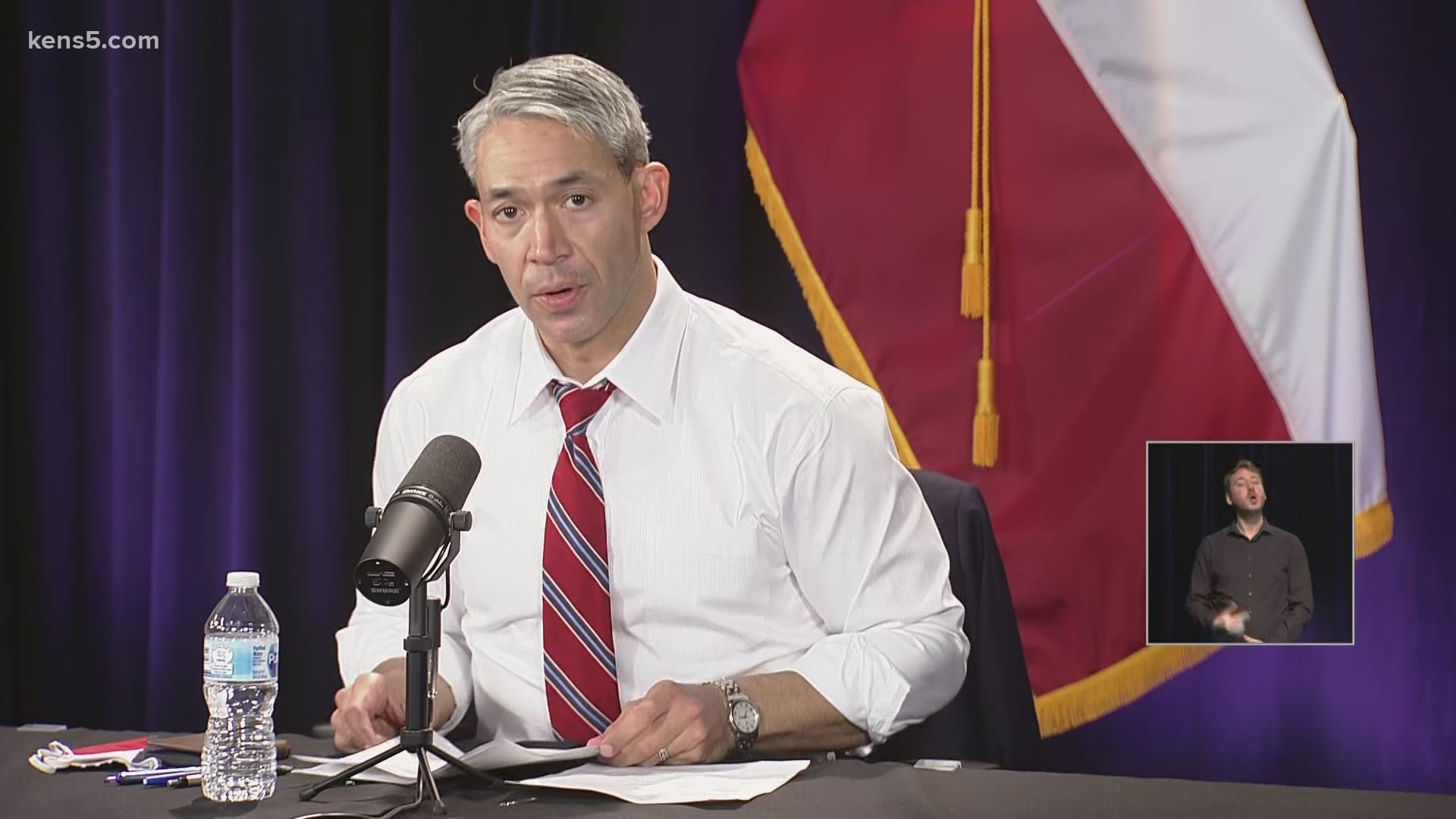SAN ANTONIO — We're tracking the latest numbers from the coronavirus pandemic in San Antonio and across Texas. Here are the latest numbers reported by Bexar and surrounding counties:
- Bexar County: On Wednesday, 1,378 new cases were reported, bringing the total number of cases to 138,785. 25 new deaths were also reported, raising the local death toll to 1,685.
- Hays County: Officials in Hays County Wednesday reported 177 new cases in the county and one additional COVID-related fatality. As of Wednesday, there are a total of 12,623 lab-confirmed local cases, while the death toll rose to 147. Officials estimate 10,287 residents have recovered, while 2,189 are still ill with the virus.
- Comal County: On Thursday, Comal County officials reported 81 new cases and three additional COVID-related fatalities. There are a total of 7,148 cases, including 4,0841 confirmed and 3,056 probable cases, while 196 county residents have died due to COVID-19 complications. The county estimates 6,091 residents have recovered, while 861 are still ill with the virus.
More county case information is available through the Texas Department of Health Services COVID-19 dashboard.
Stay updated with our latest information on coronavirus vaccines and local vaccine distribution with our ongoing Vaccine Tracker.
How Bexar County is trending
We've tracked how many coronavirus cases have been confirmed in Bexar County from the time officials began reporting cases in March 2020. The graphic below shows the number of cases since June and charts those daily case numbers along a 7-day moving average to provide a more accurate picture of the overall coronavirus case curve in our area and the direction we're trending amid the pandemic.
On Wednesday evening, San Antonio Mayor Ron Nirenberg reported an additional 1,378 novel coronavirus cases, bringing the total number of local diagnoses to 138,785. The relatively lower number of cases compared to recent days' tallies dropped the seven-day moving average to 1,688 cases a day.
Nirenberg also reported 25 additional coronavirus-related deaths in the county, one of the largest counts of new fatalities during the pandemic. (Metro Health categorizes deaths that occurred over the previous 14 days as "new" deaths.)


Meanwhile, coronavirus hospitalizations dipped slightly to 1,411 on Wednesday; that amounts to 15 fewer overall patients compared to Tuesday. The number of patients on ventilators (237) increased while the number of those in intensive care (393) went down.


Coronavirus in Texas
The total number of novel coronavirus cases in the state since the pandemic began grew by 27,343 on Wednesday, according to the Texas Department of State Health Services. That total includes 22,270 new confirmed cases, 4,538 new probable cases and 535 cases attributed to backlogs not previously reported in the state's total (more details can be found at the top of this page).
The total number of Texans diagnosed with COVID-19 surpassed 2 million Wednesday. According to DSHS data, it took more than 250 days for Texas to accumulate 1 million cases, and just 60 for that number to reach 2 million.


State health authorities also reported 405 additional virus-related deaths on Wednesday—the highest one-day fatality count since July. At least 30,624 Texans have now died from COVID-19 complications.
Meanwhile, one day after a drastic rise in the number of Texans receiving treatment at hospitals for coronavirus symptoms, the figure fell by 112 over the last 24 hours. On Wednesday, the concurrent total stood at 14,106.
The state estimates that about 1.612 million Texans have recovered, while 363,022 Texans remain ill with COVID-19.
The latest update from the Texas Education Agency showed that there have been at least 102,558 cumulative cases among staff and students across the state through January 3. That number comprises 64,574 positive student cases and 38,011 staff cases. More information can be found here.
The TEA releases new data on school cases on Fridays.
Latest Coronavirus Headlines
- University Health tightening visitor restrictions at hospitals during COVID-19 surge
- Wear The Gown: Using monoclonal antibodies to fight coronavirus
- Dollar General announces plans to pay employees to get COVID-19 vaccine
- US COVID-19 deaths hit another one-day high at over 4,300
- 'Any further issues and they will be shut down': Cowboys Dancehall at risk of closure after videos of packed venue circulate online
- For San Antonians who participated in blind COVID-19 vaccine trial, Tuesday brought a long-awaited answer
- Volunteers in demand to help with mass vaccinations at Alamodome
- Pandemic causes pediatric patient transfers at BAMC
Coronavirus symptoms
The symptoms of coronavirus can be similar to the flu or a bad cold. Symptoms include fever or chills, cough, shortness of breath or difficulty breathing, fatigue, muscle or body aches, headache, new loss of taste or smell sore throat, congestion or runny nose, nausea or vomiting, and diarrhea, according to the Centers for Disease Control.
Most healthy people will have mild symptoms. A study of more than 72,000 patients by the Centers for Disease Control in China showed 80 percent of the cases there were mild.
But infections can cause pneumonia, severe acute respiratory syndrome, kidney failure, and even death, according to the World Health Organization. Older people with underlying health conditions are most at risk.
But infections can cause pneumonia, severe acute respiratory syndrome, kidney failure, and even death, according to the World Health Organization. Older people with underlying health conditions are most at risk.
Experts determined there was consistent evidence these conditions increase a person's risk, regardless of age:
- Chronic kidney disease
- COPD (chronic obstructive pulmonary disease)
- Obesity (BMI of 30 or higher)
- Immunocompromised state (weakened immune system) from solid organ transplant
- Serious heart conditions, such as heart failure, coronary artery disease, or cardiomyopathies
- Sickle cell disease
- Type 2 diabetes
The CDC believes symptoms may appear anywhere from two to 14 days after being exposed.
Human coronaviruses are usually spread...
- Between people who are in close contact with one another (within about 6 feet).
- Through respiratory droplets produced when an infected person coughs, sneezes or talks. These droplets can land in the mouths or noses of people who are nearby or possibly be inhaled into the lungs.
- Some recent studies have suggested that COVID-19 may be spread by people who are not showing symptoms.
Help stop the spread of coronavirus
- Stay home when you are sick.
- Eat and sleep separately from your family members
- Use different utensils and dishes
- Cover your cough or sneeze with your arm, not your hand.
- If you use a tissue, throw it in the trash.
Find a Testing Location
City officials recommend getting a COVID-19 test if you experience fever or chills, cough, shortness of breath or difficulty breathing, fatigue, muscle or body aches, headache, new loss of taste or smell, sore throat, congestion or runny nose, nausea or vomiting, or diarrhea.
San Antonio operates several no-cost testing locations, including two walk-up locations open Monday-Sunday from 10 a.m. until 2 p.m.:
Cuellar Community Center
5626 San Fernando St.
San Antonio, TX 78237
Ramirez Community Center
1011 Gillette Blvd.
San Antonio, TX 78224
Additionally, Freeman Coliseum offers drive-through no-cost testing from Monday through Sunday between 9 a.m. and 4 p.m. An appointment is required and can be made either online or by calling (833) 213-0643.
Here's a Testing Sites Locator to help you find the testing location closest to you in San Antonio.

